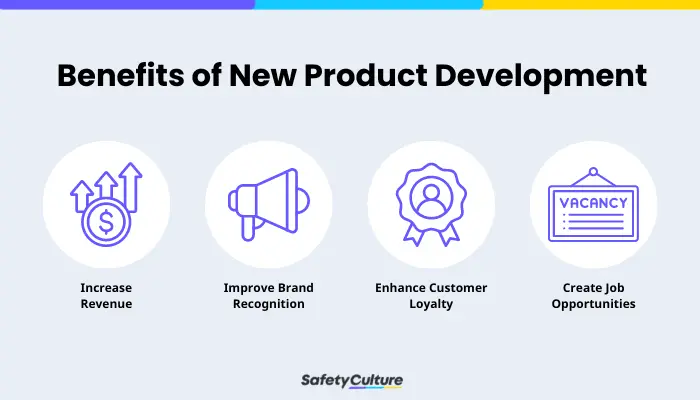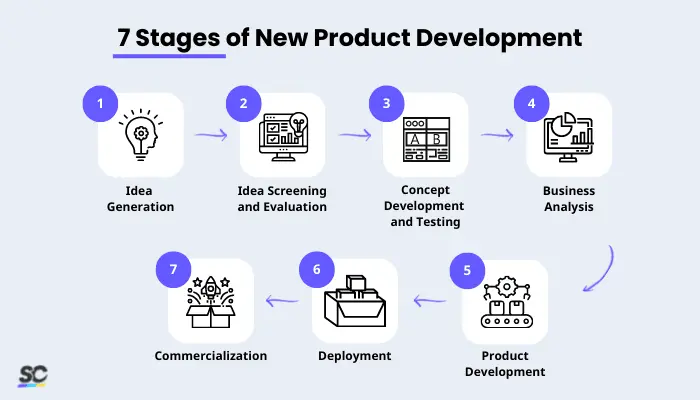What is New Product Development?
New Product Development (NPD) refers to the process of delivering a new product, service, idea, or technology to the market. The process usually follows a structured approach that involves several stages, from ideation and concept development to market research, product launch, and post-launch evaluation.
NPD is a crucial product development process for any company that wants to stay competitive and grow its business. It is a complex and iterative process requiring the involvement of several different departments, from design and engineering to marketing and sales.
Why is it Important?
New product development is important for a number of reasons, as it helps businesses:
- Keep up with the latest technological advances and trends
- Stay ahead of the competition through innovative solutions
- Diversify the product offerings and create new revenue streams
- Keep their employees engaged and motivated
New product development is not without its challenges, but the rewards can be well worth the effort. By carefully planning and executing a new product development strategy, businesses can reap the many benefits that come with successfully bringing a new product to market.
Benefits of New Product Development

4 Benefits of New Product Development
New product development is essential for any company that wants to stay competitive and relevant in today’s market. By constantly innovating and developing new products, companies can remain at the forefront of their industries and continue to grow and thrive.
There are many benefits of new product development, including the following:
- Increase Revenue – Developing new products is a great way to boost a company’s revenue. By bringing new products to market, companies can tap into new markets and capture new customers.
- Improve Brand Recognition – Launching new products can also help improve a company’s brand recognition. When done correctly, new product launches can generate a lot of buzz and media attention, which can help expose the company to new audiences.
- Enhance Customer Loyalty – New products can also help build customer loyalty. When customers see that a company has high-quality products, they tend to trust it and consequently become loyal consumers.
- Create Job Opportunities – New product development can bring new job opportunities, as companies need people to help research, develop, and market new products. All these positions require skilled workers, which can help boost the economy.
What are the Stages of New Product Development?

7 Stages of New Product Development
Stage 1: Idea Generation
Idea generation is the first stage of the NPD process. In this stage, businesses generate ideas for new products that they think will be profitable and appeal to their target market. This can be done through brainstorming sessions, customer feedback, market research, and other methods.
Stage 2: Idea Screening and Evaluation
After generating a list of potential ideas, businesses must then screen and evaluate them to see which are worth pursuing further.
This evaluation is important as it helps businesses focus their resources on the most promising ideas and avoid wasting time and money on those not likely to be successful. Factors that are typically considered during this stage include market potential, technical feasibility, and manufacturing cost.
Stage 3: Concept Development and Testing
After completing the screening and evaluation process, it is now time to move on to concept development. This is the stage wherein a detailed version of the idea is built to create a concept related to the user stories.
This stage ensures that problems or issues are discovered early on in the process and that teams can provide solutions to problems early. This also helps to stop technical debts from accumulating.
Create Your Own Product Development Inspection Checklist
Eliminate manual tasks and streamline your operations.
Get started for FREEStage 4: Business Analysis
Once a business has identified a promising product idea, it will need to conduct a thorough analysis of the opportunity. This includes assessing the needs of the target market, understanding the competition, and developing a business model.
This stage of new product development is important as it provides insights that can help determine whether or not the product is likely to be successful.
Stage 5: Product Development
In the product development stage, the product and production process is finalized. The stage starts with creating a product prototype followed by a Minimum Viable Product (MVP). After this, the product is then designed and created. Lastly, test marketing and the business analysis are finalized. All that remains is to produce the product and get it into stores.
Stage 6: Deployment
Once everything is finalized, it is now to shift to deploying the product to the market. This includes the following stages:
- Commit
- Build
- Alpha Deployment
- Beta Deployment
- Production Deployment
Stage 7: Commercialization
The last and final stage of new product development is commercialization. This is when the product is finally launched into the market. All products must go through a successful commercialization stage in order to be profitable and make it to store shelves.
The commercialization stage includes:
- Achieving index test marketed
- Product launch planning
- Demand planning and creation
- Sales forecast
Examples of NPD Initiatives
To better understand the concept of new product development, we have provided some examples to give you an idea of how it is applied to businesses.
Let’s say you are the head of a small business that sells cosmetics. You and your team have decided to branch out and begin selling skincare products in addition to your current inventory. This would be an example of new product development.
New product development can also take the form of expanding into new markets. For example, if you currently sell your products exclusively online, you may decide to open a brick-and-mortar store in order to reach a wider customer base.
Below are some examples of new product development on popularly known businesses:
- Taco Bell: adding new items to their value menu
- Samsung: releasing a new smartphone model with updated features
- Macy’s: adding new brands to their repertoire



